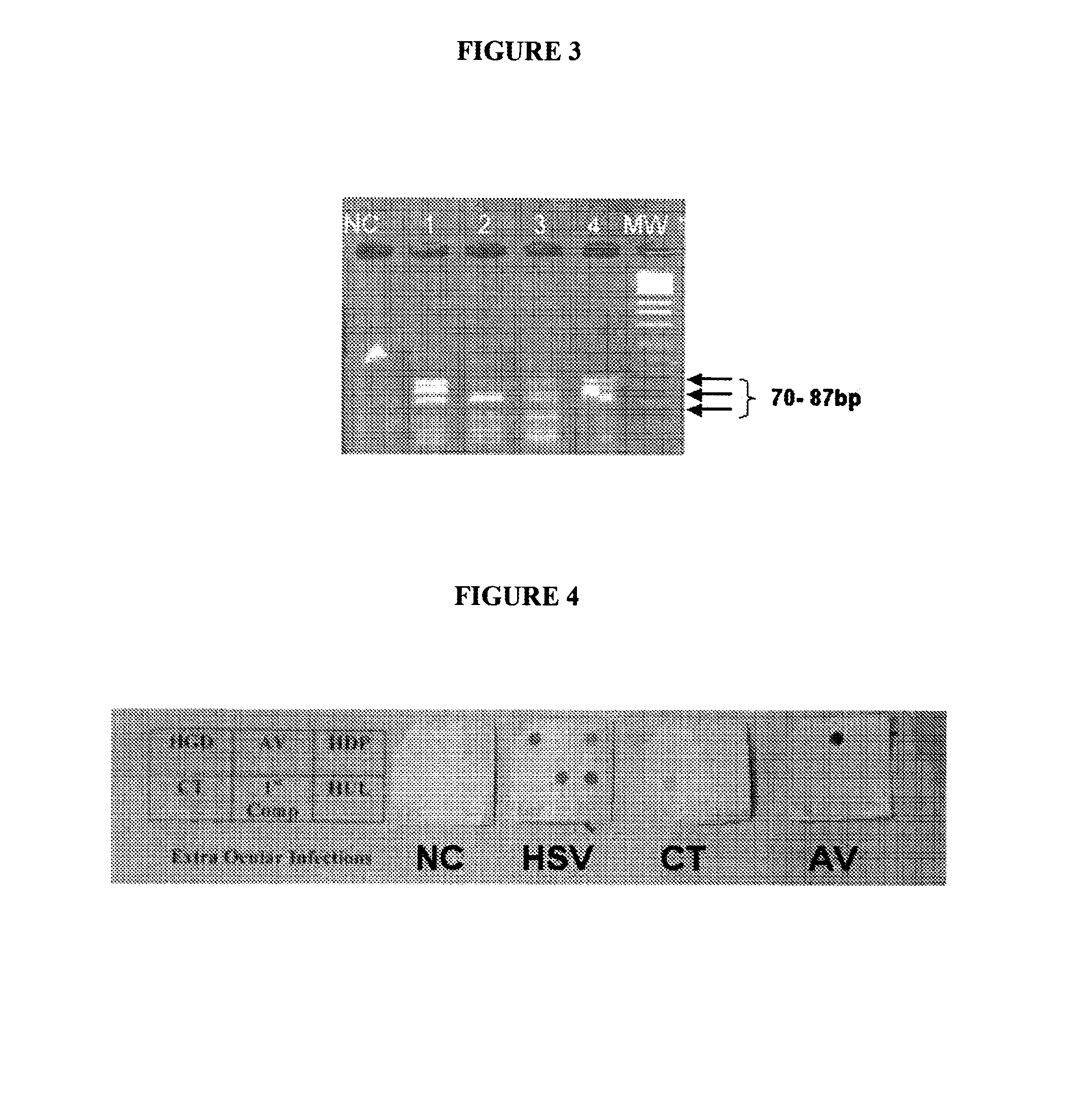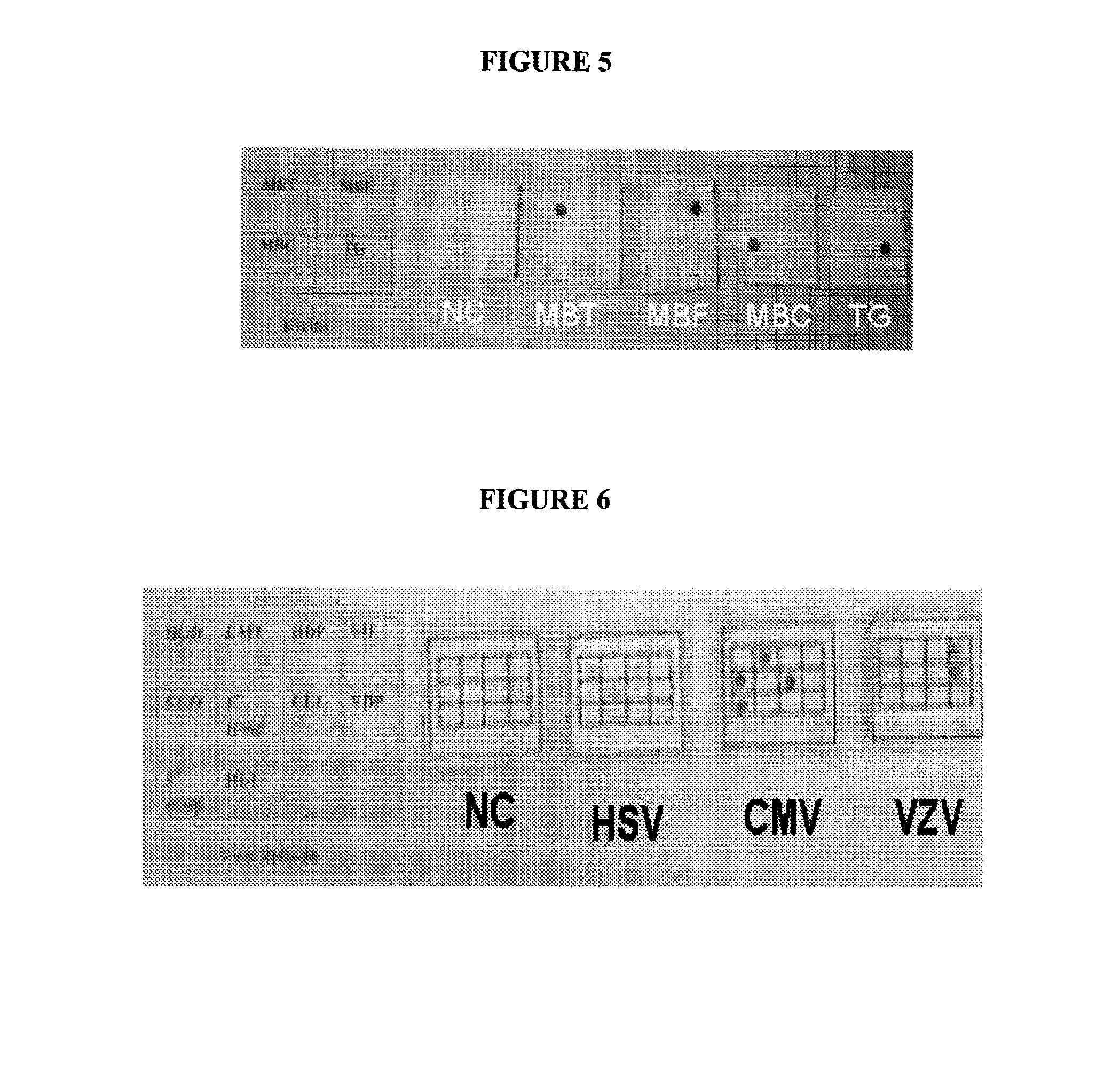Method for simultaneous detection and discrimination of bacterial, fungal, parasitic and viral infections of eye and central nervous system
a technology which is applied in the field of simultaneous detection and discrimination of eye and central nervous system bacterial, fungal, parasitic and viral infections, can solve the problems of inability to generally use diagnostic purposes, inability to detect and treat diseases, and inability to accurately detect diseases and diseases, etc., to achieve high specificity of identification and high sensitivity of pcr assay
- Summary
- Abstract
- Description
- Claims
- Application Information
AI Technical Summary
Benefits of technology
Problems solved by technology
Method used
Image
Examples
example 1
[0239]A multiplex PCR was carried out with primer sets 9 and 18, which can amplify the hexon gene of adenoviruses and polymorphic protein II gene of Chlamydia trachomatis respectively. The PCR mix contained 10 to 20 pmoles each of the forward and reverse primers, 200 μM of each d-ATP, d-UTP, d-CTP and d-GTP, 2 units of Taq polymerase in 10 mM Tris-HCl pH 9.0, 1.5 mM MgCl2, 5 mM KCl, 0.01% gelatin, 1 mM EDTA and 1 unit of UDP glycosylase to prevent amplicon contamination. The cycling conditions are being incubation at 37° C. for 30 minutes for complete digestion of any amplicon contaminants, 2 minutes at 50° C., a denaturing step of 94° C. for 5 minutes, followed by 40 cycles of 45 seconds at 60° C., 45 seconds at 72° C. and 45 seconds at 94° C. followed by 10 minutes extension of the reaction at 72° C. The product was analysed by 6% agarose gel. As can be seen in FIG. 1 both the genes got amplified. Standard DNA of 1 pg of adenovirus and 10 fg of Chlamydial DNA was used for amplific...
example 2
[0241]A multiplex PCR was carried out with primer sets 1, 2 and 3, which can amplify the Glycoprotein D, UL 44 and DNA Polymerase genes respectively. The PCR mix contained 10 pmoles each of the forward and reverse primers, 200 μM of each d-ATP, d-UTP, d-CTP and d-GTP, 2 units of Taq polymerase in 10 mM Tris-HCl pH 7.5, 1.5 mM MgCl2, 5 mM KCl, 0.01% gelatin, 1 mM EDTA and 1 unit of UDP glycosylase to prevent amplicon contamination. The cycling conditions are being incubation at 37° C. for 30 minutes for complete digestion of any amplicon contaminants, 2 minutes at 50° C. a denaturing step of 94° C. for 5 minutes, followed by 40 cycles of 45 seconds at 60° C., 45 seconds at 72° C. and 45 seconds at 94° C. followed by 10 minutes extension of the reaction at 72° C. The product was analysed by 6% agarose gel. As can be seen in FIG. 2 all the three genes got amplified
[0242]FIG. 2 shows 4% Agarose gel electrophoretogram showing the amplified products of glycoprotein D, DNA polymerase, UL-4...
example 3
[0243]A multiplex PCR was carried out with primer sets 1, 2, 3, 9 and 17 which can amplify the Glycoprotein D gene, UL 44 gene and DNA Polymerase genes of HSV, hexon gene of adenoviruses and polymorphic protein II gene of Chlamydia trachomatis respectively. The PCR mix contained 10 pmoles each of the forward and reverse primers, 200 μM of each d-ATP, d-UTP, d-CTP and d-GTP, 2 units of Taq polymerase in 10 mM Tris-HCl pH 9.0, 1.5 mM MgCl2, 5 mM KCl, 0.01% gelatin, 1 mM EDTA and 1 unit of UDP glycosylase to prevent amplicon contamination. The cycling conditions are being incubation at 37° C. for 30 minutes for complete digestion of any amplicon contaminants, 2 mins at 50° C. and a denaturing step of 94° C. for 5 minutes, followed by 40 cycles of 45 seconds at 60° C., 45 seconds at 72° C. and 45 seconds at 94° C. followed by 10 minutes extension of the reaction at 72° C. Five tubes of the PCR mix mentioned above were incubated with the following DNA preparations where in the tube NC di...
PUM
| Property | Measurement | Unit |
|---|---|---|
| volume | aaaaa | aaaaa |
| volume | aaaaa | aaaaa |
| temperature | aaaaa | aaaaa |
Abstract
Description
Claims
Application Information
 Login to View More
Login to View More - R&D
- Intellectual Property
- Life Sciences
- Materials
- Tech Scout
- Unparalleled Data Quality
- Higher Quality Content
- 60% Fewer Hallucinations
Browse by: Latest US Patents, China's latest patents, Technical Efficacy Thesaurus, Application Domain, Technology Topic, Popular Technical Reports.
© 2025 PatSnap. All rights reserved.Legal|Privacy policy|Modern Slavery Act Transparency Statement|Sitemap|About US| Contact US: help@patsnap.com



